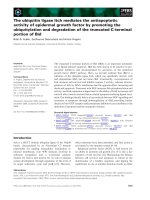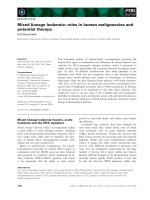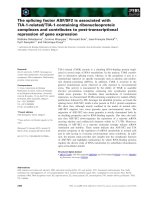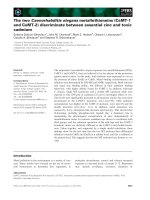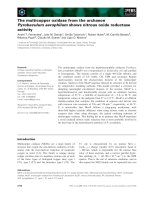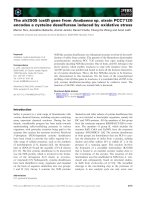Tài liệu Báo cáo khoa học: "THE EFFEC TO FEST ABLISHING COHERENCE ELLIPSIS AND ANAPHORA RESOLUTION" pdf
Bạn đang xem bản rút gọn của tài liệu. Xem và tải ngay bản đầy đủ của tài liệu tại đây (788.93 KB, 8 trang )
THE EFFECT OF ESTABLISHING COHERENCE IN
ELLIPSIS AND ANAPHORA RESOLUTION
Andrew Kehler
Harvard University
Aiken Computation Laboratory
33 Oxford Street
Cambridge, MA 02138
Abstract
This paper presents a new model of anaphoric pro-
cessing that utilizes the establishment of coherence
relations between clauses in a discourse. We sur-
vey data that comprises a currently stalemated ar-
gument over whether VP-ellipsis is an inherently
syntactic or inherently semantic phenomenon, and
show that the data can be handled within a uni-
form discourse processing architecture. This archi-
tecture, which revises the dichotomy between
ellip-
sis
vs.
Model Interpretive Anaphora
given by Sag
and Hankamer (1984), is also able to accommodate
divergent theories and data for pronominal refer-
ence resolution. The resulting architecture serves
as a baseline system for modeling the role of cohe-
sive devices in natural language.
1 Introduction
There has been much debate concerning the ap-
propriate level of language processing at which to
treat VP-ellipsis resolution. Syntactic accounts
(Fiengo and May, 1990; Hgik, 1987; Hellan, 1988;
Hestvik, 1993; Lappin, 1993; Lappin and McCord,
1990) claim that syntactic material is copied from
the antecedent clause and reconstructed in the
elided clause, whereas semantic accounts (Dalrym-
ple, 1991; Dalrymple et
al.,
1991; Gawron and Pe-
ters, 1990; Hardt, 1992; Kehler, 1993; Klein, 1987)
claim this material is retrieved from semantic rep-
resentations. This debate is currently deadlocked;
indeed a survey of the data seems to indicate that
ellipsis must be both a syntactic and semantic phe-
nomenon. In Section 2, we examine five types of
ellipsis contexts, and show a pattern that has gone
unnoticed in the literature. In Section 3 we break
the deadlock by presenting a discourse processing
architecture from which the correct predictions nat-
urally result. We present further evidence for this
architecture from pronominal NP reference resolu-
tion data in Section 4, and conclude in Section 5.
2 VP Ellipsis Data
A simple example of verb phrase (VP) ellipsis is
given in sentence (1):
(1) Ross likes his mother, and Bill does too.
The stranded auxiliary in the second clause (the
target
clause) indicates the deletion of a verb phrase,
a representation for which is to be located from an-
other clause (the
source
clause), in this case, the
first clause. Sentence (1) displays a
strict/sloppy
ambiguity: Bill may like
Ross's
mother (the strict
reading) or
his own
mother (the sloppy reading).
In this section we examine five types of elliptical
contexts, and show the following heretofore unno-
ticed pattern. 1 When the relationship between the
source clause A and the target clause B is what we
term
parallel
(as exemplified by the sentential struc-
ture
"A and B too",
as in sentence (1)), the data
indicates that a syntactic representation is recon-
structed at the target site. That is, a syntactically-
parallel source VP must be available, and recon-
struction of this VP in the target clause is subject to
syntactic constraints. However, in
non-parallel
con-
structions (for example, contrastive conjunctions
("A but B"),
subordinates
("A because B'),
and
domparatives ("A
better than B"))
neither a syn-
tactic source VP nor compliance with syntactic con-
straints is necessary, instead only a suitable seman-
tic source representation is required. These data
strongly suggest a discourse processing architecture
that is sensitive to the establishment of coherence
relations between clauses, which is described in Sec-
tion 3.
2.1 Passive/Active Alternation
Active elided target VPs can receive interpretations
from passive source VPs:
(2) In March, four fireworks manufacturers asked
that the decision be reversed, and on Monday
the ICC did. [ reverse the decision ]
(from text of Rosenthal (1988), cited in Dal-
rymple (1991)) 2
1Although space precludes us from discussing past
work in detail, no approach known to us addresses
(let alone accounts for) all of the phenomena discussed
herein.
2This use of
and
in this example does not signify a
parallel relationship between thc source and target, as
62
(3) This problem was to have been looked into, but
obviously nobody did. [ look into the problem ]
(Vincent Della Pietra, in conversation)
Less frequent, but still extant, are cases of passive
targets with active sources:
(4) In addition to inducing lethality during the
first instar, it 3 retards embryonic development,
but not to the extent that the growth cones
were. [ retarded ]
(from text of (Jarecki, 1992))
(5) Actually I have implemented it 4 with a man-
ager, but it doesn't have to be. [ implemented
with a manager ]
(Steven Ketchpel, in conversation)
These examples are problematic for syntactic anal-
yses of ellipsis, because the source clause is not a
surface VP constituent. In contrast, semantic anal-
yses cannot account for the unacceptability of sim-
ilar examples with parallel constructions:
(6) * This problem was looked into by John, and
Bob did too.
(7) * This agent retards embryonic development,
and the growth cones were too.
Syntactic parallelism is apparently required in the
parallel construction, but not in the non-parallel
ones.
2.2 Condition C Violations
Fiengo and May (1990) and Lappin (1993) note the
unacceptability of examples such as (8) and (9):
(8) * I hit Billi, and then hei did too.
(9) * Mary introduced Johnj to everyone, and hej
did too.
Under a syntactic reconstruction analysis, this is
predicted by a Condition C violation within Binding
Theory (Chomsky, 1981):
(10) * I hit Bill/, and then he/hit Bill/too.
(11) * Mary introduced Johnj to everyone, and hej
introduced Johnj to everyone too.
Because syntactic constraints do not apply at the
semantic level, semantic accounts predict these
cases to be acceptable. However, Dalrymple (1991)
gives examples where Condition C should apply but
apparently does not: 5
the use of
too
would be inappropriate under the desired
reading. We might term this relationship to be
result.
3Here,
it
refers to a previously mentioned chemical
agent.
4Here,
it
refers to a previously mentioned computer
system.
5These particular cases also violate the
Vehicle
Change
proposal of Fiengo and May (1990), which ade-
quately handles other acceptable cases that violate Con-
dition C.
(12) I expected Billi to win even when he/ didn't.
(13) The lawyer defended Billj against the accusa-
tions better than hej could have.
As these examples are non-parallel constructions,
again it appears that syntactic constraints apply in
parallel constructions but not in non-parallel ones.
2.3 Condition A Violations
As predicted by Condition A of Binding Theory, it
is generally difficult to obtain a strict reading when
the source clause contains a reflexive pronoun:
(14) ?? Johni defended himselfi, and Bobj did too.
[ defended John/]
(15) ?? Fredi voted for himself/, and Garyj did too.
[ voted for Fredi ]
Given appropriate semantic context, judgements
improve but still remain somewhat stilted: 6
(16) ? The alleged murderer/ defended himself/,
and his lawyerj did too. [ defended the alleged
murdereri ]
(17) ? Bill Clinton/ voted for himself/, and his
campaign managerj did too. [ voted for Bill
Clinton/]
The stiltedness of reflexives under a strict reading
disappears, however, in non-parallel constructions
(from Dalrymple (1991)):
(18) Billi defended himself/against the accusations
better than his lawyerj did. [ defended Billi ]
(19) John/ voted for himself/ even though no one
elsej did. [ voted for Johni ]
In these cases, the strict reading is readily available
and perhaps preferred. Again, there appears to be
a syntactic dependency in the parallel cases that is
absent from the non-parallel ones.
2.4 Non-VP Antecedents
In the following examples, the source representa-
tion is not a syntactic VP but instead comes from
a nominalization: 7
(20) This letter deserves a response, but before you
do, [ respond ]
(Gregory Ward, p.c.)
(21) Meanwhile, they sense a drop in visitors to the
city. Those who do, they say, are not taking
cabs. [ visit the city ]
(Chicago Tribune, courtesy Gregory Ward)
SThere appears to be a dialect that readily allows
strict readings with reflexives. However, even for those
speakers, the non-parallel constructions given below are
more acceptable under the strict interpretation than the
parallel cases.
~Some speakers find these cases slightly awkward or
stilted. Again, however, most find these better than the
parallel construction cases given below.
63
Semantic analyses can account for these cases if
nominalizations are assumed to evoke event repre-
sentations into the discourse model. However, in
parallel constructions, discourse-model events from
nominalizations are apparently not available:
(22) * ,This letter provoked a response from Bush,
and Clinton did too. [ responded ]
(23) * There is a rise in American visitors to the
city, and Canadians do too. [ visit the city ]
A similar pattern is seen in cases where the an-
tecedent of the ellipsis is evoked by an adjectival
phrase:
(24) First person pronouns aren't very shiftable, al-
though the plural ones can be. [ shifted ]
(Barbara Partee, in conversation)
The acceptability of example (24) is to be compared
with the relative unacceptability of an otherwise
similar parallel construction case:
(25) * First person pronouns aren't very shiftable,
and the plural ones also don't. [ shift ]
Again, non-syntactic source representations appear
to only be available in the non-parallel construction
cases.
2.5 Subjacency Violations
Ha'ik (1987) gives examples of apparent subjacency
violations in antecedent contained deletion (ACD):
(26) John read everything which Bill believes he
did.
(27) * John read everything which Bill believes the
claim that he did.
(28) * John read everything which Bill wonders
why he did.
This data is problematic for a purely semantic the-
ory of ellipsis, as there should be no syntactic de-
pendency at the ellipsis site. However, sentence
(29), which has a subordinate conjunction, does
not display the expected subjacency violation (from
Rooth (1981)): s
(29) Which problem did you think John would
solve because of the fact that Susan did?
Without ellipsis, the gap remains and a subjacency
violation results:
(30) * Which problem did you think John would
solve because of the fact that Susan solved?
In our account, the relative pronoun which does not
specify an interclausal coherence link, and therefore
sentences (26-28) are parallel constructions. Conse-
quently, again the source representation for the par-
allel construction is apparently syntactic, whereas
that for the non-parallel construction (e.g., example
(29)) is semantic.
8I thank Stuart Shieber for bringing this example to
my attention.
3 An Architecture that Exploits
Coherence
The data given in Section 2 suggests that VP-
ellipsis resolution copies a syntactic representation
in parallel constructions and a semantic represen-
tation in non-parallel ones. In this section, we
present a discourse processing architecture from
which these predictions naturally result. We first
describe Sag and Hankamer's (1984) (henceforth
S&H) earlier work, the representations from which
our analysis will utilize.
3.1 Sag and Hankamer~s Architecture
S&H give a performance-based view of anaphoric
processing that utilizes two forms of representa-
tion, a propositional representation and a discourse
model. Propositional representations, which they
conjecture are held by short-term registers in mem-
ory (henceforth propositional registers), maintain
the surface syntactic constituent structure of an
utterance as well as binding relations; however,
discourse anaphors are resolved. 9 These repre-
sentations are built in tandem with a discourse
model. S&H claim that the ellipsis resolution pro-
cess obtains referents from propositional represen-
tations, whereas what they term Model Interpre-
tive Anaphora (MIA) (e.g., 'do it' anaphora) ob-
tains referents from the discourse model. They give
the following example to illustrate (judgements are
theirs):
(31) The children asked to be squirted with the
hose, so
a. they were. [ ellipsis ]
b. * we did. [ ellipsis ]
c. we did it. [ MIA ]
In their theory, example (31a) is acceptable because
the source representation is a surface VP and there-
fore is retrievable from its propositional representa-
tion. Example (31b) is unacceptable because the
source squirt the children with the hose is not a sur-
face VP in the propositional representation3 ° Sen-
tence (31c) is acceptable because 'do it' anaphora
is an MIA process, and therefore obtains referents
from the discourse model, in which a representation
for squirt the children with the hose is assumed to
exist. One problem with this account is that it does
not explain the dichotomy of judgements for the
data given in Section 2. For each of these phenom-
ena, the S~zH approach predicts that all cases are
9In fact, they suggest that propositional represen-
tations (as opposed to classical surface structures) are
what the parser constructs, a view consistent with our
account.
1°Ellipsis, in their formulation, is subject to an
identity-o]-logical-]orm constraint on propositional rep-
resentations. See Dalrymple et al. (1991) and Hardt
(1992) for arguments that this condition is flawed.
64
either acceptable or unacceptable without regard
to the type of construction. The data instead sug-
gests that VP-ellipsis within the parallel construc-
tion behaves like S&H's definition of ellipsis, and
in non-parallel constructions it behaves like their
MIA. We believe that their dichotomy of phenom-
ena is somewhat illusory, and a more compelling
and elegant treatment is possible by appealing to
discourse structure and coherence.
3.2 A Revised Architecture
We follow S&H and earlier arguments by Johnson-
Laird (1983) in specifying a discourse processing
architecture that includes both propositional rep-
resentations and a discourse model. We propose
that a main function of the propositional repre-
sentations is to serve as a "bridge" in establishing
clause-to-clause coherence. That is, as clauses are
parsed, propositional representations are generated
and held in the short-term registers. When it is
established that a non-parallel coherence relation-
ship is present between a clause (or set of clauses)
and a subsequent clause, the propositional repre-
sentation(s) for the first is integrated into the dis-
course model so that coherence can be computed,
thereby freeing the short-term propositional reg-
ister for subsequent representations. Non-parallel
constructions specify a non-parallel coherence rela-
tionship overtly (e.g., 'contrast' (because), 'compar-
ison' (better than), 'result' (the use of and in exam-
ple 2)) 11, thereby identifying the first clause as a
unit for coherence establishment and invoking inte-
gration of its propositional representation into the
discourse model.
Parallel constructions, on the other hand, do not
invoke this integration. Hobbs (1979), in discussing
the parallel coherence relation he defines, suggests
one basis for this distinction:
One frequent function of the Parallel re-
lation is to suggest or support the gener-
alization which the two segments are spe-
cific instances of. The relation often links
segments which together function as an
Exemplification or Elaboration of a more
general statement.
In our terms, clauses conjoined by a parallel relation
will form a group and cohere as a unit with prior
and subsequent statements. Therefore, this rela-
tion in itself does not cause the representation for
the first clause to be integrated into the discourse
model. Instead, the integration of both representa-
tions into the discourse model as a unit is invoked
by subsequent coherence establishment.
11This use of and raises the question of how the lis-
tener knows which meaning of and is present during
processing. We assume that the listener can consider
multiple possibilities in parallel, although it may also be
that in these cases the interclausal relationship has been
established by the time the ellipsi~ site is processed.
The preceding analysis makes the predictions
necessary to account for the ellipsis data given in
Section 2. Under our account, the representation of
an utterance either exists in a propositional regis-
ter or in the discourse model; these are not cre-
ated in tandem as S&H suggest. An elided VP
then receives an interpretation from whichever rep-
resentation is available. The parallel construction
cases in Section 2 are unacceptable because the
source clause has not been integrated into the dis-
course model when the ellipsis site is processed.
The source must therefore be retrieved from the
propositional representation, where surface syntac-
tic structure and binding relations are maintained.
Reconstructing this representation requires syntac-
tic parallelism (ruling out passive/active and nomi-
nalization cases) and can result in violation of syn-
tactic constraints (such as Condition C violations,
Condition A violations, or subjacency violations).
The non-parallel construction cases in Section 2 are
acceptable because the antecedent for the ellipsis
has been integrated into the discourse model when
the ellipsis site is processed. Because the vestiges
of syntactic information are no longer present in
the representation, syntactic constraint violations
do not occur; furthermore source representations
from nominalizations and clauses of differing voice
now exist in the discourse model, x2
3.3 Examples
In this section, we work through two examples to
illustrate the proposals that have been made thus
far. For resolution at the syntactic level, we as-
sume an S&H-like propositional representation and
a straightforward mechanism whereby a VP repre-
sentation is copied from the source clause represen-
tat.ion into the target clause representation. For res-
olution in the discourse model, we will use the event
representation and resolution algorithm defined in
(Kehler, 1993). The focus of this section, however,
is to offer a general illustration of the architecture
rather than to make specific claims concerning the
12Differences remain between the distribution of
S&tt's ellipsis and MIA phenomena that need to be
accounted for in a comprehensive treatment of event
anaphora, as examples (31a-c) show (although judge-
ments as to the unacceptability of sentence (31b) vary).
Interestingly, contra S&H, MIA phenomena also appear
to be sensitive to syntactic constraints in certain con-
texts, as the following example from Dalrymple (1991)
shows:
* I hit Suei, and then she1 did it.
One hypothesis is that VP-ellipsis is actually event
anaphora with an empty pronoun; it may then be that
distributional differences between "do ¢", "do it', and
"do that" are due only to the anaphoric properties of the
event pronoun involved, and not due to a fundamental
difference between ellipsis and MIA phenomena. This
hypothesis is the subject of ongoing work.
65
nature of the representations involved.
Examples (32) and (33) exhibit the contrast be-
tween parallel and non-parallel constructions with
active target clauses that have passive source
clauses, as discussed in Section 2.1:
(32) * John was shot by Bob, and Bill did too.
(33) John was shot by Bob because Bill wouldn't.
The propositional representation for the source
clause in these sentences is shown in representation
(34), where P denotes the passive voice:
(34) [ P [ was.shot'(by(Bob')) ] (John') ]
Because the two clauses in sentence (32) stand in a
parallel relationship, the source representation has
not been integrated into the discourse model at the
time the ellipsis site is processed; therefore the el-
lipsis is resolved at the propositional level of repre-
sentation. A representation is constructed with the
information present in the target clause:
(35) [ A [ ] (Bill') ]
Here A denotes the active voice, a feature which
is indicated in the target clause through the use of
did.
When the elided VP is retrieved, a mismatch
occurs: the passive VP cannot be brought into a
representation marked as having active voice. The
copying can therefore not be completed, resulting
in the unacceptability of the sentence.
Sentence (33) also has representation (34) for its
source clause. However, because the two clauses
stand in a non-parallel relationship, representation
(34) has already been integrated into the discourse
model when the ellipsis site is processed, and thus
resolution occurs in the discourse model. The rep-
resentation for the source clause is:
(36) el: [predicate: shot
time: past
polarity: positive
modality: necessity
agent: Bob
theme: John ]
Because this representation is based upon thematic
(and not syntactic) roles, the representations for ac-
tive and passive forms of a sentence are identical.
For the target clause, a parallel event representa-
tion is created with empty roles, and the role fillers
present in the target clause are filled in:
(37) e~: [ predicate:
time: past
polarity: negative
modality: volitional_possibility
agent: Bill
theme:]
Representations for the the remaining role fillers are
retrieved from the source clause representation:
(38) e2: [predicate: shot
time: past
polarity: negative
modality: volitional_possibility
agent: Bill
theme: John ]
This resolution successfully yields the correct rep-
resentation for the target clause in sentence (33).
Examples (39) and (40) illustrate the contrast be-
tween parallel and non-parallel constructions with
respect to potential Condition C violations, as de-
scribed in Section 2.2:
(39) * The lawyer defended Bil4 and hei did too.
(40) The lawyer defended Bill/ better than hei
could have.
In each sentence, the propositional representation
for the source clause takes the form given in (41):
(41) [[ defend'(nill') ] (lawyerl') ]
Because the two clauses in sentence (39) stand in a
parallel relationship, the source representation has
not been integrated into the discourse model at the
time the ellipsis site is processed. The ellipsis is
then resolved at the propositional level of represen-
tation. After filling in the information present in
the target clause and copying the representation of
the source VP, representation (42) results: 13
(42) [[ defend'(Bill/) ] (he/') ]
A manifestation of Condition C applying at this
level rules out this representation asill-formed, be-
cause the pronoun
he
c-commands the coreferential
NP form
Bill.
Sentence (40) also has representation (41) for
its source clause. Because the two clauses stand
in a non-parallel relation, representation (41) has
already been integrated into the discourse model
when the ellipsis site is processed. Resolution then
occurs in the discourse model. The representation
for the source clause is:
(43) e3: [predicate: defend
time: past
modality: necessity
agent: lawyer 1
theme: Bill ] .
After creating a parallel event representation, fill-
ing in role fillers present in the target clause, and
retrieving remaining role fillers from the source rep-
resentation, representation (44) results:
(44) e4: [predicate: defend
time: past
modality: possibility
agent: Bill
theme: Bill ]
13Recall that pronouns have been resolved at this
level of representation; we indicate this by coindexing.
66
Because no syntactic constraints apply at this level
of representation, representation (44) is well-formed
and yields the correct interpretation for the target
clause.
In summary, our architecture accounts for data
supporting both the syntactic and semantic ac-
counts of ellipsis resolution in an elegant and in-
tuitive way. Section 4 examines pronominal NP
resolution in this model.
4 Pronoun Resolution
There are also dichotomous views in the literature
concerning the process by which pronoun resolu-
tion is performed. Theories incorporating a notion
of local focus generally utilize syntactic information
in their specifications. For example, the Centering
framework of Grosz et al. (1986) utilizes grammat-
ical role information in specifying the accessibility
of potential referents on an ordered forward-looking
center list. Kameyama's work (Kameyama, 1988)
contains rules for property sharing utilizing gram-
matical roles. Passonneau (1991), in looking at the
distribution of 'it' and 'that' for NP reference in
naturally-occurring texts, concludes that both syn-
tactic form of the antecedent and its grammatical
role are needed to adequately account for the data.
Furthermore, she suggests that the function of the
propositional register discussed by S&H is appro-
priate for accommodating her rules.
Alternatively, some researchers (Hobbs, 1979;
Wilensky, 1978) have suggested that coreference is
determined as a by-product of coherence determi-
nation between sentences. In Hobbs' account, for
example, pronouns are modeled as free variables
and are assigned to objects during the process of
establishing coherence relations.
However, Hobbs himself acknowledges the power
of grammatical role-based heuristics, 14 noting that
upon hearing example (45),
(45) John can open Bill's safe. He
one is likely to assume that John is the referent of
He. The existence of a garden-path effect in ex-
ample (46), where He refers to Bill instead of John,
suggests that pronominal reference resolution is not
guided by coherence considerations alone:
(46) John can open Bill's safe. He's going to have
to get the combination changed soon.
As focus-based theories would predict, the reader
assigns John as the referent of He, and double-
takes when semantic information later suggests
otherwise. 15 Our architecture provides an expla-
nation for this phenomenon. Since a coherence
14Hobbs (1976) found that a heuristic favoring sub-
jects over objects was 90% accurate for written texts.
15This effect causes Hobbs to admit that "this
strongly suggests that some psychological reality un-
derlies the heuristic [ favoring subjects over objects ]."
relation has not been established at the time the
pronoun is processed, the propositional representa-
tion for the first clause (which preserves information
that focus-based theories utilize, such as surface-
string ordering and depth-of-embedding of poten-
tial referents) is the representation available to the
reference resolution algorithm. 16 However, when a
non-parallel coherence link is overt, our architecture
would predict that a semantically-based resolution
process would be used because the propositional
representation containing potential referents has al-
ready been integrated into the discourse model at
the time the pronoun is processed. This predic-
tion is borne-out empirically; consider the follow-
ing two sentence prefixes (complete sentences taken
from (Ehrlich, 1980)):
(47) Steve blamed Frank and he [ spilt the cof-
fee
].
(48) Steve blamed Frank because he [ spilt the
coffee ].
Focus-based theories predict the strong bias toward
the referent of he in example (47) being the subject
(i.e., Steve), even though he is consistent with both
potential referents. Because this sentence is a par-
allel construction (i.e., the meaning of "and" is not
result), our architecture also makes this prediction
in accordance with those theories. The heuristic
preferring subjects does not apply in example (48),
where Frank is perhaps the preferred referent of he,
seemingly as a result of reasoning using semantic
features of the verb blame. Our architecture cor-
rectly predicts that the pronoun in sentence (48)
does not cause processing problems while the one
in example (46) does, because only in sentence (48)
has the clause containing the referent of he been in-
tegrated into the discourse model at the time the
pronoun is processed.
Ehrlich (1980) gives experimental evidence sup-
porting this view. Ehrlich's goal was to test the bi-
asing effect of the so-called "implicit causality" fea-
ture (Garvey and Caramazza, 1974) of verbs such
as blame in pronoun reference assignment in two-
clause sentences with conjunctions other than be-
cause (which was the only conjunction used in pre-
vious work (Garvey el al., 1976)). In her experi-
ments, subjects were tested for their ability to iden-
tify correct referents of pronouns in three versions
of six two-clause sentences (such as those in sen-
tences (47) and (48)), where each of the sentences
contained one of the conjunctions and, but, and be-
cause. It was found that subjects were significantly
more accurate in determining correct referents of
aSAfter garden-pathing, "off-line" reasoning appar-
ently allows the reader of example (46) to identify the
correct referent of the pronoun. This reasoning may al-
low propositional representations to be integrated into
the discourse model so that Hobbs-like coherence deter-
mination can be performed.
67
pronouns when the conjunction used was
because
or
but,
and therefore that the effect of implicit causal-
ity was not constant with respect to the conjunction
used. While a detailed analysis of her work is be-
yond the scope of this paper, two generalizations
that she draws as a result of her experiments are:
(1) that subjects were more able to utilize 'gen-
eral knowledge' in determining the referent when
the conjunction used was
because
or
but
than when
it was
and;
and (2) that hearers analyze language
a clause at a time. The first of these results sup-
ports our view that semantic information required
for reasoning is primarily available in the discourse
model (since the representation for the first clause is
integrated into the discourse model when the con-
junction used is
but
or
because);
the second point
supports our claim that the propositional registers
hold clause-level representations. 17
In summary, our architecture also accommo-
dates evidence supporting competing theories of
how pronominal NP resolution is performed.
5 Conclusions
This paper presents a model for anaphoric process-
ing that incorporates the role of establishing coher-
ence relationships between clauses in a discourse.
By postulating the existence of propositional rep-
resentations in addition to a discourse model, we
account for ellipsis data that has gridlocked work
on the topic. Furthermore, arguments for dichoto-
mous approaches to pronoun resolution are resolv-
able within this framework.
It should be noted that coherence establishment
is not likely to be the only discourse factor involved
in integrating propositional representations into the
discourse model. Therefore, the analysis described
herein only indicates tendencies, as opposed to pre-
dicting cut-and-dry judgements on the basis of type
of construction alone. For instance, example (49)
has been judged by some speakers to be acceptable
under a strict reading: is
(49) I voted for myself, and I hope you did too!
Our account predicts that this case would be at
least somewhat stilted due to a Condition A viola-
tion. One factor distinguishing this example from
17 Ehrhch's results with the conjunction
and
are mixed
with respect to our theory, as in some cases her partic-
ipants preferred a non-subject position referent over a
subject position one. In particular, she notes that this
happens when the main verb of the second clause is
the stative verb
be,
as in
Sue criticized Penny and she
was gloomy.
These sentences contain the
resultmeaning
of
and as
opposed to the parallel one. Unfortunately,
Ehrlich's original data was not available at the time of
this writing so an analysis distinguishing between uses
of
and
could not be performed.
lsI thank an anonymous reviewer for this example.
others we have discussed is the use of first and sec-
ond person pronouns, and a second is the fact that
the pronominal referent necessary to yield the strict
reading is also present in the target clause. Future
work is needed to further analyze the effects of these
differences.
The theory presented here evokes many other
questions for future study. One such question is
how the postulated representations should be fur-
ther formalized, and how reasoning with these for-
malizations is to be performed. A second question
is how this conception of discourse processing may
be integrated with theories of discourse structure
(Grosz and Sidner, 1986; Scha and Polanyi, 1988;
Webber, 1991). While we have looked primarily
at two-clause structures, the ramifications that the
claims have on multi-clause discourse structure re-
quire further investigation. Such studies will form
the basis for further characterization of the role of
coherence establishment in anaphoric processing.
Acknowledgments
This work was supported in part by National Sci-
ence Foundation Grant IRI-9009018, National Sci-
ence Foundation Grant IRI-9157996, and a match-
ing grant for the latter from the Xerox Corporation.
I would like to thank Mary Dalrymple, Barbara
Grosz, Shalom Lappin, Karen Lochbaum, Christine
Nakatani, Stuart Shieber, and two anonymous re-
viewers for valuable discussions and comments on
earlier drafts.
References
(Chomsky, 1981) Noam Chomsky.
Lectures in Gov-
ernment and Binding.
Foris, Dordrecht, 1981.
(Dalrymple et
al.,
1991) Mary Dalrymple, Stuart
M. Shieber, and Fernando Pereira. Ellipsis and
higher-order unification.
Linguistics and Philo-
sophy,
14:399-452, 1991.
(Dalrymple, 1991) Mary Dalrymp!e. Against re-
construction in ellipsis. Technical Report SSL-
91-114, Xerox, 1991.
(Ehrlich, 1980) Kate Ehrlich. Comprehension of
pronouns.
Quarterly Journal of Experimental
Psychology,"
32:247-255, 1980.
(Fiengo and May, 1990) Robert Fiengo and Robert
May. Anaphora and ellipsis, ms., City Univer-
sity of New York and University of California at
Irvine, 1990.
(Garvey and Caramazza, 1974) C. Garvey and
A. Caramazza. Implicit causality in verbs.
Lin-
guistic Inquiry,
5:549-564, 1974.
(Garvey
et al.,
1976) C. Garvey, A. Caramazza,
and J. Yates. Factors underlying assignment
of pronoun antecedents.
Cognition,
3:227-243,
1976.
68
(Gawron and Peters, 1990) Mark Gawron and
Stanley Peters. Anaphora and Quantification in
Situation Semantics. CSLI/University of Chicago
Press, Stanford University, 1990. CSLI Lecture
Notes, Number 19.
(Grosz and Sidner, 1986) Barbara Grosz and Can-
dace Sidner. Attention, intentions, and the strc-
ture of discourse. Computational Linguistics,
12(3):175-204, 1986.
(Grosz et al., 1986) Barbara J. Grosz, Aravind K.
Joshi, and Scott Weinstein. Towards a computa-
tional theory of discourse interpretation. Unpub-
lished manuscript, 1986.
(Ha'/k, 1987) Isabelle Ha'ik. Bound variables that
need to be. Linguistics and Philosophy, 11:503-
530, 1987.
(Hardt, 1992) Daniel Hardt. VP ellipsis and con-
textual interpretation. In Proceedings of the In-
ternational Conference on Computational Lin-
guistics (COLING-92), Nantes, July 1992.
(Hellan, 1988) Lars Hellan. Anaphora in Norwe-
gian and the Theory of Grammar. Studies in
Generative Grammar 32. Forts, Dordrecht, 1988.
(Hestvik, 1993) Arild Hestvik. Strict reflexives and
the subordination effect. In S. Berman and
A. Hestvik, editors, Proceedings of the Stuttgart
Workshop on Ellipsis: Arbeitspapiere des Son-
derforschungsbereich 340, Berichl Nr. 29-1992,
SFB 340. University of Stuttgart, University of
Tuebingen, and IBM Germany, 1993.
(Hobbs, 1976) Jerry Hobbs. Pronoun resolution.
Technical Report 76-1, Department of Computer
Science, City University of New York, 1976.
(Hobbs, 1979) Jerry Hobbs. Coherence and coref-
erence. Cognitive Science, 3:67-90, 1979.
(Johnson-Laird, 1983) P. N. Johnson-Laird. Men-
tal Models: Towards a Cognitive Science of Lan-
guage, Inference, and Consciousness. Cambridge
University Press, 1983.
(Kameyama, 1988) Megumi Kameyama. Japanese
zero pronominal binding: Where syntax and dis-
course meet. In William J. Poser, editor, Pa-
pers from the Second International Workshop on
Japanese Syntax, pages 47-74. CLSI, 1988.
(Kehler, 1993) Andrew Kehler. A discourse copy-
ing algorithm for ellipsis and anaphora resolu-
tion. In Proceedings of the Sixth Conference of the
European Chapter of the Association for Com-
putational Linguistics (EACL-93), Utrecht, the
Netherlands, April 1993.
(Klein, 1987) Ewan Klein. VP-Ellipsis in DR the-
ory. In Groenindijk and Stokhof, editors, Studies
in Discourse Representation Theory and the The-
ory of Generalized Quantifiers. Forts, 1987.
(Lappin and McCord, 1990) Shalom Lappin and
Michael McCord. Anaphora resolution in slot
grammar. Computational Linguistics, 16:197-
212, 1990.
(Lappin, 1993) Shalom Lappin. The syntactic ba-
sis of ellipsis resolution. In S. Berman and
A. Hestvik, editors, Proceedings of the Stuttgart
Workshop on Ellipsis: Arbeitspapiere des Son-
derforschungsbereich 340, Bericht Nr. 29-i992,
SFB 340. University of Stuttgart, University of
Tuebingen, and IBM Germany, 1993.
(Passonneau, 1991) Rebecca Passonneau. Persis-
tence of linguistic form in discourse processing.
In Proceedings of the Fall Symposium on Dis-
course Structure in Natural Language Under-
standing and Generation, Monterey, CA, Novem-
ber 1991.
(Rooth, 1981) Mats Rooth. A comparison of three
theories of verb phrase ellipsis. University of Mas-
sachusetts Occasional Papers in Linguistics, Vol-
ume 7, 1981.
(Sag and Hankamer, 1984)Ivan Sag and Jorge
Hankamer. Toward a theory of anaphoric pro-
cessing. Linguistics and Philosophy, 7:325-345,
1984.
(Scha and Polanyi, 1988) Remko Scha and Livia
Polanyi. An augmented context free grammar
for discourse. In Proceedings of the Interna-
tional Conference on Computational Linguistics
(COLING-88), pages 573-577, Budapest, August
1988.
(Webber, 1991)Bonnie Lynn Webber. Struc-
ture and ostension in the interpretation of dis-
course deixis. Language and Cognitive Processes,
6(2):107-135, 1991.
(Wilensky, 1978) Robert Wilensky. Understanding
Goal-Based Stories. PhD thesis, Yale, 1978. Re-
search Report #140.
Sources of Examples
(Jarecki, 1992) Jill Jarecki. The role ofsynaptic ac-
tivity during embryonic neuromuscular junction
development in drosophila melangestr. Unpub-
lished Yale University Prospectus, August 1992.
(Rosenthal, 1988) Harry F. Rosenthal. Agency or-
ders UPS to resume fireworks deliveries-after
July 4th. Associated Press Newswire, June 1988.
69



